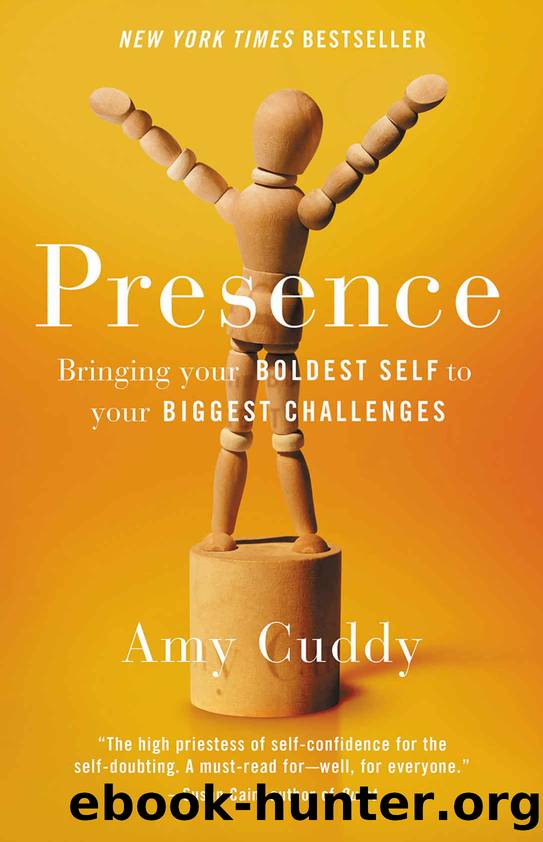Presence by Amy Cuddy

Author:Amy Cuddy [Cuddy, Amy]
Language: eng
Format: azw3
Tags: Economics / Women In Business, Business &, Nonverbal Communication, Business &, Economics / Leadership, Self-Help / General, Psychology / Social Psychology, Social Science / Body Language &
Publisher: Little, Brown and Company
Published: 2015-12-21T16:00:00+00:00
Presence Through the Body
He walked along the River Lee, his hands clasped behind his back. A new walk for him. Large and public. The attitude of a thinking man. He enjoyed the pose, found it conducive to the idea of himself.
âColum McCann, TransAtlantic, describing Frederick Douglass
The âidea of oneselfâ is an intriguing concept. The self can, presumably, be anything you want it to be. It can even be new, but that doesnât make it insincere or inauthentic. It suggests that you can think of yourself in a certain way and then take steps to bring that self into existence. In the example above, from a 2013 novel by Colum McCann, it means steps in the literal sense: Frederick Douglass, the nineteenth-century African American civil rights activist, walked a new walk, struck a fresh pose, and enjoyed itâhe found it conducive to the idea of the person he thought himself to be.
Our bodies, McCann suggests, donât just carry us where we want to go: they can help carry us to who we want to be. And, as weâre about to discover, the evidence seems to agree: where our bodies lead, our minds and emotions will follow.
To understand this phenomenon, it will help to look at what happens when the body betrays us, locking us into a defensive, fearful, hypervigilant state rather than leading us to greater personal power. Iâm talking about post-traumatic stress.
Download
This site does not store any files on its server. We only index and link to content provided by other sites. Please contact the content providers to delete copyright contents if any and email us, we'll remove relevant links or contents immediately.
Professional Troublemaker by Luvvie Ajayi Jones(29417)
Whiskey Words & a Shovel I by r.h. Sin(19187)
Rewire Your Anxious Brain by Catherine M. Pittman(18286)
Healthy Aging For Dummies by Brent Agin & Sharon Perkins RN(16919)
Cat's cradle by Kurt Vonnegut(14756)
Talking to Strangers by Malcolm Gladwell(12864)
The Art of Thinking Clearly by Rolf Dobelli(9908)
They Both Die at the End by Adam Silvera(9480)
The 5 Love Languages: The Secret to Love That Lasts by Gary Chapman(9272)
Doing It: Let's Talk About Sex... by Hannah Witton(9074)
The Compound Effect by Darren Hardy(8504)
Thirteen Reasons Why by Jay Asher(8447)
Goodbye, Things by Fumio Sasaki(8287)
Wonder by R.J. Palacio(8265)
Atomic Habits: Tiny Changes, Remarkable Results by James Clear(8043)
Becoming Supernatural by Dr. Joe Dispenza(7831)
Tools of Titans by Timothy Ferriss(7806)
Wonder by R. J. Palacio(7736)
Should I Stay or Should I Go? by Ramani Durvasula(7427)
